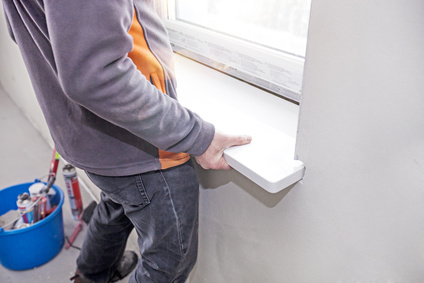As window sills are an important element of interior design, they should be chosen to match type of the window or style of the room. Window sills also need to be functional i.e. they must be able to act as a barrier to dust or promote the circulation of warm air (so that the air is directed into the room, not to the window glazing). It is important that the window sills are made of adequate materials and in a proper shape.
Installing an internal window sill
Internal window sills should be installed, either before or after plastering, at the user’s discretion. Bear in mind, however, that for correct and steady setting of the window sill it is most likely required to chisel out some part of the wall, which will make the work more difficult after plastering has been carried out.
While an installation of a window sill is not a complicated procedure, have in mind a few important guidelines.
 Installing an internal window sill
Installing an internal window sill
First, it should be taken into account that the window sill is installed at a height approx. 12-15 cm above the radiator so as to ensure proper distribution of warm air inside the room Second, the window niche should be widened by approx. 3-4 cm on each side. Positioning the window sill in an opening made this way will improve fastening stability.
At this stage of work attention should be paid to the gap between the window and the wall – it should be approx. 1-2 cm, so that the window sill can be easily slid under the frame. Some window profiles already include a dedicated recess for inserting the sill. T
his makes the connection between the sill and the window structure much tighter, thus limiting heat losses. It is also possible to apply polyurethane foam to fill the empty space between the window sill and the frame.
Then the window sill is measured and levelled so that it slopes at least by 2% towards the inside. Dedicated wedges can be used for this purpose.
Important: install the window sill only a smooth, levelled, vacuumed and, if necessary, degreased surface.
Material for the installation of the window sill should be selected depending mainly on the material of the sill. Wood, PVC or conglomerate material is best fixed with polyurethane foam. Assembly glue can be also used for this purpose as it is more versatile and is suitable for most types of internal window sills.
Note! If the window sill protrudes from the wall to a large extent, it should be additionally supported with appropriate brackets.
How to choose a window sill for the interior?
Do not install window sills with distinct decorative features under normal plastic windows. The reverse also applies – avoid ordinary sills for windows with decorative frames.
It is advisable to match a wooden or wood-like window sill with a wooden window. A stone window sill will also look well-matched, however.
If you have a white window, it is advisable to match it with a white window sill, for example made of PVC (PVC window sills are lightweight, easy to keep clean, and inexpensive). A wooden or steel window sill painted in white will also suit such a window.
What is the purpose of a window sill?
The purpose of a window sill depends, among others, on the room it will be installed in. If the window sill in to be installed in the bathroom, pay attention to the material of which it is made – it needs to be resistant to moisture.
Best window sills for the bathroom are made of stone – they are resistant to temperature variations and do not absorb water. PVC or ceramic window sills will also serve their purpose in the bathroom.
Sills installed in the kitchen should also be resistant to moisture and scratching. Try to match the colours of the kitchen window to those of the kitchen worktop.
The living room and other rooms are a match with tasteful window sills that harmonise with the entire interior. Here, wooden and stone window sills are best
To sum up: planning an installation of a window sill, make sure that you choose a sill that matches the window (in terms of material and colour) and the design of the interior, so that the outcome is consistent.
While installation of a window sill is not very challenging, it is important to carry it out properly. First of all, fix the sill firmly and tightly. If you install the sills with proper care, there will be no thermal bridges, and the installed sills will be stable and look appealing.







